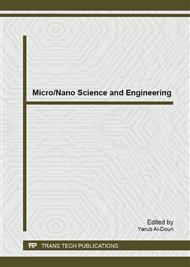p.96
p.101
p.105
p.110
p.115
p.120
p.125
p.130
p.135
The Effects of Process Parameters on the Pyrolysis of Empty Fruit Bunch (EFB) Using a Fixed-Bed Reactor
Abstract:
Malaysia is well-known as one of the main producer and exporter of palm oil. With the high production of crude palm oil (CPO), huge amount of empty fruit bunch was generated as by-products. The abundant amount of EFB produced required careful waste management procedures. Pyrolysis is thermochemical decomposition of biomass in inert environment towards its conversion into bio-oil, bio-char and gas. In this study, the pyrolysis of empty fruit bunch (EFB) was conducted using a fixed bed reactor. The pertinent process parameters such as pyrolysis temperature, particle sizes and heating rates were investigated via the determination of the percentage product yields such as bio-oil, bio-char and gas. The first series of experiment was conducted to determine the effect of pyrolysis temperatures. The final pyrolysis temperature was varied at 300, 400, 500, 600 and 700 °C at constant heating rates and the nitrogen flowrates of 30 °C/min and 100 cm3/min respectively. It was determined that at pyrolysis temperature of 500 °C maximum bio-oil yield of 35.00 % was obtained with bio-char and gas yield of 26.98 and 38.02% respectively. In the second series of experiment, the effect of particle sizen was studied. The EFB particle was varied at <125, 125-250, 250-500, 500-710 and 710-1000 μm. The pyrolysis temperature was fixed at 500 °C with nitrogen flowrate of 100 cm3/min and heating rate of 30 °C/min. It was determined that using EFB particle size of 250-500 μm, the maximum bio-oil of 38.52% was achieved with bio-char and gas yields of 25.06 % and 36.42% respectively. In the third series of experiment to determine the effect of heating rates, the heating rates was varied at 10, 20, 30, 40, 50 and 60 °C/min towards the final pyrolysis temperature of 500 °C with constant nitrogen flowrates of 100 cm3/min. The results obtained showed that the highest amount of bio-oil of 40.81% was obtained when the heating rate of 20 °C/min was used. The bio-char and gas yield obtained were 24.69% and 34.50% respectively.
Info:
Periodical:
Pages:
115-119
Citation:
Online since:
April 2014
Authors:
Keywords:
Price:
Сopyright:
© 2014 Trans Tech Publications Ltd. All Rights Reserved
Share:
Citation:


